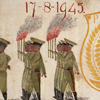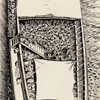Drawings from the camps in the occupied Dutch East Indies (1942-1945) > Liberation

On 15 August 1945, Japan gave up the fight after an atomic bomb had been dropped on the Japanese cities of Hiroshima and Nagasaki. But the Allied Forces did not land in the occupied Dutch East Indies until the official Japanese surrender had been signed on 2 September 1945. Because of the Indonesian fight for independence, it was not safe for the internees to leave the camps and so they had to stay inside. On the authority of the Allied general Mountbatten, it was up to the Japanese to maintain order. Everywhere, rations were quickly increased; meat, oil, fruit and sugar made their entry into the camps. The guards became more friendly, rules were violated without anybody paying attention. People started searching for their relatives with the help of the Red Cross. Only then did some of them find out that their husband, wife, father or mother had died.
Bersiap

Two days after the Japanese had laid down arms, on 17 August 1945, the Indonesian leaders Sukarno and Hatta proclaimed the independent republic of Indonesia. This started a bloody fight for independence, that would eventually lead to the recognition of Indonesia’s independence by the Netherlands in December 1949. The Pemudas, extremist and revolutionary Indonesian youths, rose in an ever more violent revolt. They wanted Indonesia to be for the Indonesians and their actions were directed at all foreigners, be they Dutch, of mixed Indonesian Dutch descent, British, Japanese or even pureblood Indonesians who supported the Dutch. The situation became so agitated in Java and later also in Sumatra that the former internees were ordered to remain in the camps; outside they ran the risk of being killed. Only in convoy, escorted by soldiers, could they venture into the streets. Since the first allied troops did not land in Java until the end of September and in Sumatra until mid October, the Japanese came to be the protectors of their former internees and prisoners until the Allied Forces could assume the management of the camps. The time that elapsed between the liberation and the beginning of 1946 is called the Bersiap period. Bersiap was a revolutionary battle cry of the Pemudas, meaning ‘Be ready’. Many people of mixed Indonesian Dutch descent experienced this period as more traumatic than the Japanese occupation. Many of them who had remained free till then ended up in a Japanese camp and some later on in an Indonesian camp for “extremists”. Thousands fell victim to terror.
Repatriation

Many internees went to Australia to recuperate. There, children could go back to school. The Australian authorities put schoolrooms at their disposal for that purpose. Starting in 1946, more than 300,000 people of mixed descent and full-blood Dutch people, so-called totoks, whose families had sometimes lived from generation to generation in the East, were repatriated by ship to the Netherlands. Most of them were not to return to their “Tropic of Emerald”, as a Dutch film director called the archipelago. The pre-war Netherlands East Indies had disappeared for ever. Many people of mixed descent experienced the repatriation as a forced journey to a country they only knew from the history and geography lessons in school. They were heading for hard times.
